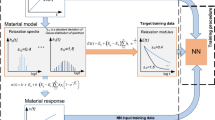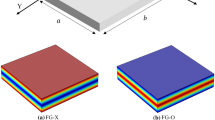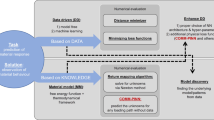Abstract
Recurrent neural network (RNN)-based accelerated prediction was achieved for the long-term time-dependent behavior of viscoelastic composite laminated Mindlin plates subjected to arbitrary mechanical and hygrothermal loading. Time-integrated constitutive stress-strain relation was simplified via Laplace transform to a linear system to reduce the computational storage. A fast converging smooth finite element method named cell-based smoothed discrete shear gap was employed to enhance the data generation procedure for straining RNNs with a sparse mesh. This technique is applicable under varying hygrothermal conditions for real engineering structure problems with fluctuating temperature and moisture. Hence, accurate RNN-based long-term deformation prediction for laminated structures was realized using the history of environmental temperature and moisture condition.
Similar content being viewed by others
References
H. F. Brinson and L. C. Brinson, Polymer Engineering Science and Viscoelasticity: An Introduction, Springer, Berlin (2008).
R. Christensen, Theory of Viscoelasticity: An Introduction, Elsevier, Amsterdam (2012).
K. Y. Lin and Y. Sung, Analysis of interlaminar stresses in viscoelastic composites, International Journal of Solids and Structures, 27 (1991) 929–945.
J. Rouzegar and M. Gholami, Creep and recovery of viscoelastic laminated composite plates, Composite Structures, 181 (2017) 256–272.
S. Yi and H. H. Hilton, Hygrothermal effects on viscoelastic responses of laminated composites, Composites Engineering, 5 (1995) 183–193.
R. Bradshaw and L. Brinson, Mechanical response of linear viscoelastic composite laminates incorporating non-isothermal physical aging effects, Composites Science and Technology, 59 (1999) 1411–1427.
A. H. Muliana and S. Sawant, Responses of viscoelastic polymer composites with temperature and time-dependent constituents, Acta Mechanica, 204 (2009) 155–173.
S. Sawant and A. Muliana, A thermo-mechanical viscoelastic analysis of orthotropic materials, Composite Structures, 83 (2008) 61–72.
K. Y. Lin and I. Hwang, Thermo-viscoelastic analysis of composite materials, Journal of Composite Materials, 23 (1989) 554–569.
H. H. Hilton and S. Yi, Anisotropic viscoelastic finite element analysis of mechanically and hydrothermally loaded composites, Composites Engineering, 3 (1993) 123–135.
M. F. Şahan, Dynamic analysis of linear viscoelastic cross-ply laminated shallow spherical shells, Composite Structures, 149 (2016) 261–270.
T. M. Chen, The hybrid Laplace transform/finite element method was applied to the quasi-static and dynamic analysis of viscoelastic Timoshenko beams, International Journal for Numerical Methods in Engineering, 38 (1995) 509–522.
M. Abouhamzeh, J. Sinke, K. Jansen and R. Benedictus, A new procedure for thermo-viscoelastic modeling of composites with general orthotropy and geometry, Composite Structures, 133 (2015) 871–877.
S.-N. Nguyen, J. Lee and M. Cho, Efficient higher-order zigzag theory for viscoelastic laminated composite plates, International Journal of Solids and Structures, 62 (2015) 174–185.
S.-N. Nguyen, J. Lee and M. Cho, A triangular finite element using Laplace transform for viscoelastic laminated composite plates based on efficient higher-order zigzag theory, Composite Structures, 155 (2016) 223–244.
S.-N. Nguyen, J. Lee and M. Cho, Viscoelastic behavior of Naghdi shell model based on efficient higher-order zig-zag theory, Composite Structures, 164 (2017) 304–315.
S.-N. Nguyen, J. Lee, J.-W. Han and M. Cho, A coupled hygrothermo-mechanical viscoelastic analysis of multilayered composite plates for long-term creep behaviors, Composite Structures, 242 (2020) 112030.
S.-N. Nguyen, T. T. Truong, M. Cho and N.-T. Trung, A cell-based smoothed finite element formulation for viscoelastic laminated composite plates considering hygrothermal effects, Journal of Composite Materials (2020) 0021998320980054.
S.-N. Nguyen, J. Lee and M. Cho, Efficient higher-order plate theory for viscoelastic composite laminates, 54thAIAA/ASME/ASCE/AHS/ASC Structures, Structural Dynamics, and Materials Conference (2013) 1542.
S.-N. Nguyen, J. Lee and M. Cho, Finite element for viscoelastic composite plate bending using efficient higher-order displacement field, 54th AIAA/ASME/ASCE/AHS/ASC Structural Dynamics, and Materials Conference (2014) 0508.
S.-N. Nguyen, J. Lee and M. Cho, Higher-order zigzag laminated composite shell theory for viscoelastic behavior, 56th AIAA/ASCE/AHS/ASC Structural Dynamics, and Materials Conference (2015) 1189.
N. N. Sy, J. Lee and M. Cho, Application of the Laplace transformation for the analysis of viscoelastic composite laminates based on equivalent single-layer theories, International Journal of Aeronautical and Space Sciences, 13 (2012) 458–467.
S. L. Deleeuw, Theory of Viscoelasticity, an introduction (second edition), by R. M. Christensen, The Journal of the Acoustical Society of America, 74 (1983) 1311.
D. Roylance, Engineering Viscoelasticity, Department of Materials Science and Engineering, Massachusetts Institute of Technology, Cambridge MA (2001) 2139 1–37.
M. Abouhamzeh, J. Sinke, K. Jansen and R. Benedictus, Thermo-viscoelastic analysis of GLARE, Composites Part B: Engineering, 99 (2016) 1–8.
N. Joshi and A. Muliana, Deformation in viscoelastic sandwich composites subject to moisture diffusion, Composite Structures, 92 (2010) 254–264.
G. Liu, K. Dai and T. T. Nguyen, A smoothed finite element method for mechanics problems, Computational Mechanics, 39 (2007) 859–877.
G.-R. Liu and N. Trung, Smoothed Finite Element Methods, CRC Press, Boca Raton (2016).
T. Nguyen-Thoi, P. Phung-Van, H. Nguyen-Xuan and C. Thai-Hoang, A cell-based smoothed discrete shear gap method using triangular elements for static and free vibration analyses of Reissner-Mindlin plates, International Journal for Numerical Methods in Engineering, 91 (2012) 705–741.
Y. LeCun, Y. Bengio and G. Hinton, Deep learning, Nature, 521 (2015) 436–444.
M. Guo and J. S. Hesthaven, Reduced-order modeling for nonlinear structural analysis using gaussian process regression, Computer Methods in Applied Mechanics and Engineering, 341 (2018) 807–826.
J. Kaliszuk and Z. Waszczyszyn, Reliability analysis of structures by neural network supported Monte Carlo methods, Neural Networks and Soft Computing (2003) 754–759.
A. Koeppe, F. Bamer and B. Markert, An efficient Monte Carlo strategy for elastoplastic structures based on recurrent neural networks, Acta Mechanica, 230 (2019) 3279–3293.
M. Papadrakakis, V. Papadopoulos and N. D. Lagaros, Structural reliability analysis of elastic-plastic structures using neural networks and Monte Carlo simulation, Computer Methods in Applied Mechanics and Engineering, 136 (1996) 145–163.
J. Ghaboussi, J. J. Garrett and X. Wu, Knowledge-based modeling of material behavior with neural networks, Journal of Engineering Mechanics, 117 (1991) 132–153.
J. Ghaboussin and D. Sidarta, New nested adaptive neural networks (NANN) for constitutive modeling, Computers and Geotechnics, 22 (1998) 29–52.
A. A. Javadi and M. Rezania, Intelligent finite element method: an evolutionary approach to constitutive modeling, Advanced Engineering Informatics, 23 (2009) 442–451.
R. Hambli, Application of neural networks and finite element computation for multiscale simulation of bone remodeling, Journal of Biomechanical Engineering, 132 (2010) 114502.
R. Hambli and A. Barkaoui, Multiscale approach for bone remodeling simulation based on finite element and neural network computation, arXiv preprint arXiv:11073817 (2011).
J. Schmidhuber and S. Hochreiter, Long short-term memory, Neural Computation, 9 (1997) 1735–1780.
T. Nguyen-Thoi, P. Phung-Van, C. Thai-Hoang and H. Nguyen-Xuan, A cell-based smoothed discrete shear gap method (CS-DSG3) using triangular elements for static and free vibration analyses of shell structures, International Journal of Mechanical Sciences, 74 (2013) 32–45.
S. Hochreiter, Untersuchungen zu dynamischen neuronalen Netzen, Master’s Thesis, Technische Universität München, Germany (1991).
Y. Bengio, P. Simard and P. Frasconi, Learning long-term dependencies with gradient descent is difficult, IEEE Transactions on Neural Networks, 5 (1994) 157–166.
M. Abadi et al., Tensorflow: large-scale machine learning on heterogeneous distributed systems, arXiv preprint arXiv: 160304467 (2016).
F. Crossman, R. Mauri and W. Warren, Moisture-altered viscoelastic response of graphite/epoxy composites, Advanced Composite Materials-Environmental Effects, ASTM International, West Conshohocken (1978) 205–220.
Acknowledgments
This work was supported by the National Research Foundation (NRF) of Korea funded by the Korean government (MSIP) (Grant No. 2012R1A3A2048841).
Author information
Authors and Affiliations
Corresponding authors
Additional information
Sy-Ngoc Nguyen is a Researcher of the Institute of Computational Science, Ton Duc Thang University, Ho Chi Minh City, Vietnam. He received his Ph.D. in Mechanical Engineering from Seoul National University. His research interests include solid mechanics, composite materials, plate and shell structures, finite element analysis, and viscoelasticity.
Chien Truong-Quoc is a Ph.D. student of the Department of Mechanical and Aerospace Engineering, Seoul National University, Seoul, Korea. He received his Master in Mechanical Engineering from Hanoi University of Science and Technology. His research interests include solid mechanics, dynamic analysis, and neural network computation.
Jang-woo Han is an Assistant Professor of the Department of Mechanical Design Engineering, Kumoh National Institute of Technology, Gumi, Korea. He received his Ph.D. in Mechanical Engineering from Seoul National University. His research interests include solid mechanics, viscoelasticity, and composite laminated plate and shell structures.
Sunyoung Im is a Ph.D. student of the Department of Mechanical and Aeropace Engineering, Seoul National University, Seoul, Korea. She received her Master in Mechanical Engineering from Seoul National University. Her research interests include neural network constitutive modeling, nonlinear structure analysis, and system reduction computation.
Maenghyo Cho is a Professor of the Department of Mechanical and Aeropace Engineering, Seoul National University, Seoul, Korea. He received his Ph.D. in Mechanical Engineering from the University of Washington. His research interests include continuum mechanics, multiscale simulation multiphysics analysis, and composite materials.
Rights and permissions
About this article
Cite this article
Nguyen, SN., Truong-Quoc, C., Han, Jw. et al. Neural network-based prediction of the long-term time-dependent mechanical behavior of laminated composite plates with arbitrary hygrothermal effects. J Mech Sci Technol 35, 4643–4654 (2021). https://doi.org/10.1007/s12206-021-0932-2
Received:
Revised:
Accepted:
Published:
Issue Date:
DOI: https://doi.org/10.1007/s12206-021-0932-2




